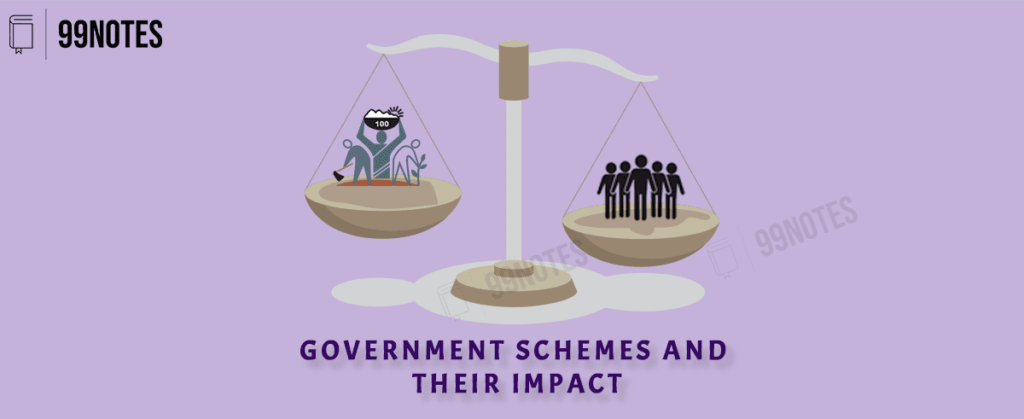
Government Schemes and Their Impact Free UPSC Notes Download

Indirect Subsidies
The Government provides a variety of subsidies to the farmers in India. All such subsidies can be classified into: Indirect Subsidies: Those subsidies that are provided through market intervention. These subsidies distort the prices in the market. These can further be divided as

Crop Insurance
PM Fasal Bima Yojana aims to reduce the premium rates to be paid by the farmers so as to enable more farmers to avail insurance cover against crop loss on account of natural calamities. It further aims to Increase the insurance coverage in India to 50% of the total crop area

Buffer stock
Buffer stock: a reserve of a commodity that is used to offset price fluctuations and unforeseen emergencies.
Generally, Buffer stock is maintained for essential commodities such as food grains, pulses etc. NAFED is now maintaining a buffer stock of Onions, Tomatoes and potatoes under the TOP scheme.

Food Security
Food security: When Food is enough, there is no barrier to access to food & all persons have the capacity to buy food. UN’s Committee on World Food Security: all people, at all times, have physical, social, and economic access to sufficient, safe, and nutritious food that meets their food preferences and dietary
Government Schemes and Their Impact
- Government schemes are an important tool for addressing a range of social and economic issues in India. These schemes are implemented by the central, state, and local governments and aim to achieve specific goals such as improving education, healthcare, employment, and living standards for citizens.
Some examples of government schemes in India include:
- Mahatma Gandhi National Rural Employment Guarantee Act (MNREGA): This scheme aims to provide guaranteed employment to rural households in India. It provides financial assistance to households for unskilled manual labor on public works projects such as building roads, bridges, and water bodies. The MNREGA has had a positive impact on rural employment and incomes, especially for vulnerable groups such as women, Scheduled Castes, and Scheduled Tribes. It has also helped to improve infrastructure in rural areas and has had a positive effect on the local economy.
- Pradhan Mantri Jan Dhan Yojana (PMJDY): This scheme aims to provide access to financial services, such as bank accounts and insurance, to underserved and unbanked populations in India. It aims to promote financial inclusion and empower individuals to take control of their financial lives. The PMJDY has had a positive impact by increasing the number of bank accounts held by citizens, especially in rural areas and among vulnerable groups. It has also helped to increase the use of formal financial services, such as loans and insurance, which can provide financial stability and security.
- Pradhan Mantri Aawas Yojana (PMAY): This scheme aims to provide affordable housing to all citizens of India by 2022. It provides financial assistance to households for the construction or upgrade of a dwelling unit, as well as subsidies for home loans. The PMAY has had a positive impact by increasing the availability of affordable housing and improving living conditions for many citizens. It has also contributed to the growth of the construction and real estate sectors, which can have a positive impact on the economy.
- Swachh Bharat Abhiyan (Clean India Campaign): This scheme aims to improve sanitation and cleanliness in India. It provides funding for the construction of toilets, encourages the use of toilets, and promotes waste segregation and management. The Swachh Bharat Abhiyan has had a positive impact by increasing the availability of toilets, particularly in rural areas, and improving hygiene and sanitation. It has also contributed to the improvement of public health and the environment, as well as the overall quality of life for citizens.
In addition to these schemes, there are many other government schemes that have been implemented in India to address a range of issues and challenges.
Some examples include the Sarva Shiksha Abhiyan, which aims to improve education and reduce illiteracy, and the National Health Mission, which aims to improve healthcare access and outcomes.
Overall, government schemes can have a positive impact by providing resources and support to underserved populations, improving access to essential services and infrastructure, and promoting the development of key sectors such as education, healthcare, and housing.
However, the effectiveness of a government scheme may depend on various factors such as implementation, monitoring, and evaluation. It is important for the government to ensure that schemes are implemented effectively and efficiently in order to maximize their impact and achieve their intended goals.

